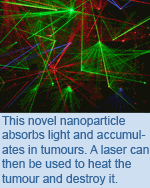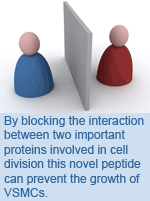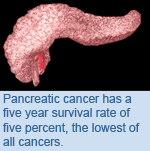
March 2011
 A team of OCI scientists led by Dr. Gang Zheng has created an organic, non-toxic and biodegradable nanoparticle—a minute molecule with novel properties—that uses light and heat to deliver drugs and treat cancer.
A team of OCI scientists led by Dr. Gang Zheng has created an organic, non-toxic and biodegradable nanoparticle—a minute molecule with novel properties—that uses light and heat to deliver drugs and treat cancer.
Dr. Zheng’s team combined two naturally occurring molecules (chlorophyll and lipid) to create a unique nanoparticle that shows promise for numerous diverse light-based (biophotonic) applications. They found that the nanoparticle was able to absorb light and accumulate in tumours. They then used a laser to rapidly heat the tumour to a temperature of 60 degrees to destroy it. Once the nanoparticle hit its tumour target, it became fluorescecent to indicate successful targeting of the cancer. The nanoparticle can also be used for photoacoustic imaging, which combines light and sound to produce a high-resolution image that can be used to find and target tumours.
“These findings are significant because unlike other nanoparticles, this new nanoparticle has a unique, versatile structure and unprecedented safety,” explains Dr. Zheng. “There are many nanoparticles out there, but this one is the complete package for various types of cancer imaging and treatment options that can now be mixed and matched in ways previously unimaginable. We are excited by the possibilities for its use in the clinic.”
Porphysome nanovesicles generated by porphyrin bilayers for use as multimodal biophotonic imaging agents. Lovell JF, Jin CS, Huynh E, Jin H, Kim C, Rubinstein JL, Chan WC, Cao W, Wang LV, Zheng G.
Nature Materials. 2011 Mar 20. [Pubmed abstract]
This work was supported by grants from the Ontario Institute for Cancer Research, the Canadian Cancer Society, the Natural Sciences and Engineering Research Council of Canada, the Canadian Institutes of Health Research, the Joey and Toby Tanenbaum/Brazilian Ball Chair in Prostate Cancer Research, and in part from the Campbell Family Institute for Cancer Research and the Ministry of Health and Long-Term Planning.
 Under normal conditions, vascular smooth muscle cells (VSMCs)—cells that make up all blood vessel walls—replicate, or divide, at very low rates. However, these rates commonly increase in vascular disease, typically resulting in narrowing of the blood vessels which can have a negative affect on blood flow and vessel function.
Under normal conditions, vascular smooth muscle cells (VSMCs)—cells that make up all blood vessel walls—replicate, or divide, at very low rates. However, these rates commonly increase in vascular disease, typically resulting in narrowing of the blood vessels which can have a negative affect on blood flow and vessel function.
Building on their previous findings, Dr. Mansoor Husain’s group at TGRI designed a synthetic peptide that disrupts the interaction between two key proteins: Calmodulin and cyclin E, as a mechanism to slow the progression of cell division. Administration of the peptide resulted in decreased numbers of VSMCs and reduced thickening of the arterial wall following injury, without causing toxicity or cell death.
“By targeting a specific aspect of cell division we could inhibit cell proliferation and minimize damage to surrounding areas, common in disorders such as restenosis, a relatively frequent consequence of balloon angioplasty,” explains Dr. Husain. “Our work supports further development of this novel therapy to treat these conditions.”
Peptide-mediated disruption of calmodulin-cyclin E interactions inhibits proliferation of vascular smooth muscle cells and neointima formation. Hui S, Choi J, Zaidi S, Momen A, Steinbach SK, Sadi AM, Ban K, Husain M. Circulation Research. 2011 Mar 3. [Pubmed abstract]
This work was supported in part by funding from the Canadian Institutes of Health Research.
 New findings from Drs. David Hedley and Igor Jurisica at OCI have increased our understanding of the link between hypoxia (oxygen deprivation) in solid tumours and cancer metastasis.
New findings from Drs. David Hedley and Igor Jurisica at OCI have increased our understanding of the link between hypoxia (oxygen deprivation) in solid tumours and cancer metastasis.
The OCI team established xenografts (tissue grafted between species) from 16 patients undergoing surgery for pancreatic cancer and maintained the xenografts in the pancreas of immune-deprived mice. They examined how hypoxia related to the aggressiveness of tumour spread and found that hypoxia was highly correlated with rapid tumour growth, cell proliferation, spontaneous metastasis formation and increased expression of genes involved in cell survival and proliferation.
“Our results suggest that hypoxia is a major adverse prognostic factor in pancreatic cancer,” explains Dr. Hedley. “We are conducting a clinical trial to measure hypoxia directly in pancreatic cancer patients and are also testing strategies to target hypoxia.”
Hypoxia predicts aggressive growth and spontaneous metastasis formation from orthotopically-grown primary xenografts of human pancreatic cancer.
Chang Q, Jurisica I, Do T, Hedley DW. Cancer Research. 2011 Feb 22. [Pubmed abstract]
This work was supported by the John and Esther Loewen Family Fund, the Ontario Institute for Cancer Research, the Ontario Research Fund, the Canada Foundation for Innovation, the Canada Research Chairs program, IBM and the Ontario Ministry of Health and Long-Term Care.
 According to statistics released by the Public Health Agency of Canada in June 2009, there are approximately 300,000 Canadians living with the effects of stroke. Moreover, patients with stroke have a four- to six-fold higher prevalence of obstructive sleep apnea (OSA). In the poststroke period, patients with OSA have greater functional impairment and higher mortality rates than patients without OSA. Thanks to a recent study from TGRI’s Dr. T. Douglas Bradley and his team at the Toronto Rehabilitation Institute (TRI), there is promising new evidence that continuous positive airway pressure (CPAP) treatment helps to improve functional and motor outcomes for stroke patients with OSA.
According to statistics released by the Public Health Agency of Canada in June 2009, there are approximately 300,000 Canadians living with the effects of stroke. Moreover, patients with stroke have a four- to six-fold higher prevalence of obstructive sleep apnea (OSA). In the poststroke period, patients with OSA have greater functional impairment and higher mortality rates than patients without OSA. Thanks to a recent study from TGRI’s Dr. T. Douglas Bradley and his team at the Toronto Rehabilitation Institute (TRI), there is promising new evidence that continuous positive airway pressure (CPAP) treatment helps to improve functional and motor outcomes for stroke patients with OSA.
The study used a randomized, open-label, parallel patient group with blind assessment of outcomes performed in stroke patients with OSA in TRI’s stroke rehabilitation program. Patients were assigned to standard rehabilitation alone (the control group) or to a CPAP group. After a four-week treatment period, patients in the CPAP group experienced significant benefits, including improvements in motor tests as assessed by the Canadian Neurological Scale (a validated tool for assessing the neurological status of stroke patients) and the Functional Independence Measure (a uniform measure of disability scored on the basis of how much assistance is required for an individual to carry out daily living activities).
“This study demonstrated that treating OSA with CPAP in stroke patients is associated with significant improvements in functional and motor outcomes as well as mood,” states Dr. Bradley. “This is a great finding as functional and motor impairments are often the most disabling features of stroke because they limit mobility and daily living activities. What we need now is longer-term trials to determine whether these improvements can persist or evolve with time.”
Influence of continuous positive airway pressure on outcomes of rehabilitation in stroke patients with obstructive sleep apnea.
Ryan CM, Bayley M, Green R, Murray BJ, Bradley TD.
Stroke. 2011 March 3. [Pubmed abstract].
This work was supported by the Physicians' Service Incorporated Foundation.
 Intracerebral hemorrhage (ICH) is a devastating form of stroke that affects over two million people per year. It is associated with a staggering mortality rate of up to 40% in the first month, and a poor prognosis for survivors. Because therapeutic options are very limited beyond reducing the bleeding and edema (swelling of the brain), there is a critical need to understand the underlying factors that are involved in the damage. The brain’s inflammatory response can injure white matter—the part of the brain that contains the ‘connectors’ between nerve bodies—and this damage has been correlated with deterioration and poor functional recovery in patients. Recent findings from Dr. Lyanne Schlichter and her team at TWRI shed new light on the contribution of neutrophils—immune cells involved in the ICH early inflammatory response—to damage after ICH.
Intracerebral hemorrhage (ICH) is a devastating form of stroke that affects over two million people per year. It is associated with a staggering mortality rate of up to 40% in the first month, and a poor prognosis for survivors. Because therapeutic options are very limited beyond reducing the bleeding and edema (swelling of the brain), there is a critical need to understand the underlying factors that are involved in the damage. The brain’s inflammatory response can injure white matter—the part of the brain that contains the ‘connectors’ between nerve bodies—and this damage has been correlated with deterioration and poor functional recovery in patients. Recent findings from Dr. Lyanne Schlichter and her team at TWRI shed new light on the contribution of neutrophils—immune cells involved in the ICH early inflammatory response—to damage after ICH.
To examine the specific role of neutrophils, the team used an experimental rodent model in which neutrophils were depleted prior to inducing ICH. The study showed that neutrophil depletion led to a number of changes, including reduced leakiness of the blood-brain barrier (the protective barrier in brain capillaries that keeps the environment in the brain as stable as possible) and lower levels of Matrix Metalloprotease 9, an inflammatory molecule that is believed to contribute to injury. Injury to white matter was also reduced at the damage site.
“This study provides exciting evidence that neutrophils play a significant role in ICH-induced damage, including breakdown of the blood-brain barrier, which can lead to edema,” states Dr. Schlichter. “We are just beginning to address the roles of the various inflammatory factors that contribute to the deterioration and poor functional recovery of these patients. Further efforts to elucidate the evolving inflammatory response will hopefully lead to more effective treatments.”
Neutrophil depletion reduces blood-brain barrier breakdown, axon injury, and inflammation after intracerebral hemorrhage.
Journal of Neuropathology and Experimental Neurology. 2011 Mar;70(3):218-35.
[Pubmed abstract].
This work was supported by the Heart & Stroke Foundation of Canada (Ontario Chapter).
 Understanding the workplace experiences of individuals with arthritis is important for ensuring better workplace interventions and to prevent at-work disability and job loss. A recent study by Dr. Monique Gignac (TWRI) provides insight into the type, degree and episodic nature of arthritis-related workplace activity limitations and the consistency of the relationship of these limitations to job modifications and workplace outcomes.
Understanding the workplace experiences of individuals with arthritis is important for ensuring better workplace interventions and to prevent at-work disability and job loss. A recent study by Dr. Monique Gignac (TWRI) provides insight into the type, degree and episodic nature of arthritis-related workplace activity limitations and the consistency of the relationship of these limitations to job modifications and workplace outcomes.
The group interviewed 490 individuals with osteoarthritis (OA), inflammatory arthritis (IA) or both, four times over a period of four and a half years using the Workplace Activity Limitations Scale (WALS) to assess arthritis-related disability with job tasks such as schedule, hours, pace of work, sitting, standing, working with the hands and getting around work. Overall, the WALS scores were consistent across the different time points. Over time, however, at the individual level there was considerable fluctuation in workplace activity limitations, due in part to the episodic nature of arthritis. In fact, nearly three quarters of participants reported changes in workplace activity limitations. In some cases, limitations increased but in others it decreased. There were no significant differences between the different types of arthritis across activities, with the exception of tasks involving the hands, where individuals with rheumatoid arthritis (a type of IA) scored consistently higher than individuals with OA.
Individuals with medium WALS scores were more likely to use gadgets or assistive devices, while absenteeism and help from workplace professionals was more often associated with individuals with high WALS scores. Explains Dr. Gignac, “These results suggest that difficulties are often intermittent and may not result in changes to work productivity until they are consistently high. This is important for designing workplace interventions and for employers, insurers, and government to understand to avoid viewing individuals with arthritis as a permanent drain on workplace and health resources. It also points to the need for increased early intervention to help prevent negative job outcomes in the long-term. A medium WALS score may signal the need for workplace strategies to be implemented.”
An examination of arthritis-related workplace activity limitations and intermittent disability over four and a half years and its relationship to job modifications and outcomes. Gignac MA, Cao X, Tang K, Beaton DE. Arthritis Care & Research (Hoboken). 2011 Feb 25. [Pubmed abstract].
This work was supported by grants from the Canadian Institutes of Health Research, the Canadian Arthritis Network, a Networks of Centres of Excellence, and by an Ontario Ministry of Health System-Linked grant to the Arthritis Community Research & Evaluation Unit.

![]()
 Congratulations to Drs. Amit Oza, Geoffrey Liu, Doris Howell and Benjamin Neel, who have received funding from the Cancer Care Ontario Applied Research Units. The OCI/PMH investigators received three out of six grants awarded this year.
Congratulations to Drs. Amit Oza, Geoffrey Liu, Doris Howell and Benjamin Neel, who have received funding from the Cancer Care Ontario Applied Research Units. The OCI/PMH investigators received three out of six grants awarded this year. Dr. Amit Oza (Director, Clinical Cancer Research Unit, Co-Director Bras Drug Development Program) will lead the "Princess Margaret Hospital Consortium", a group of investigators who carry out clinical trials of investigational cancer medicines. Drs. Geoffrey Liu (Alan B. Brown Chair in Molecular Genomics) and Doris Howell (Royal Bank of Canada Financial Group Chair, Oncology and Nursing Research) will co-lead "On-PROST: Ontario Patient Reported Outcomes of Symptoms and Toxicity", a large research team focused on developing and implementing Patient Reported Outcome Measures (PROMS). Dr. Benjamin Neel (Director, OCI and Campbell Family Institute for Cancer Research) will lead a group towards the creation of a joint Genomics Research Unit that successfully meets the challenge of making personalized medicine a reality through the "Personalized Medicine with Targeted and Genome-Wide Sequencing" program.
Feedback/To Unsubscribe
Net Results EXPRESS is brought to you by UHN Research Communications. We hope you have enjoyed receiving this message. If you have any feedback, or if you wish to unsubscribe, please email www@uhnresearch.ca.
To access archived issues of Net Results EXPRESS, visit uhnresearch.ca/news/netresultsexpress
Some images adapted from the image archives of stock.xchng.ca.